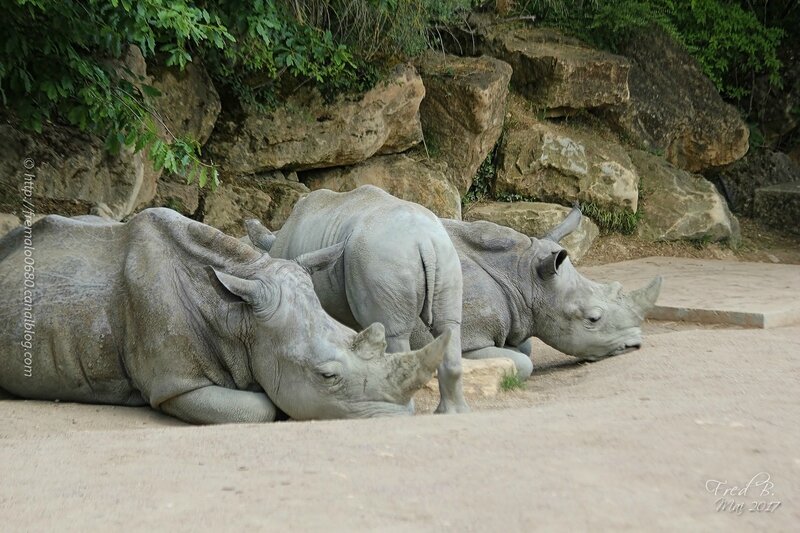En danger * Endangered
Le rhinocéros blanc (Ceratotherium simum) est appelé ainsi suite à une erreur de traduction. Le mot néerlandais wijde(«large» en français) a été traduit par white en anglais. Il est en fait gris clair et l'adjectif large a pour sujet ses lèvres qui le distingue du rhinocéros noir (Diceros bicornis) qui a lui des lèvres "pointues". Cette différence explique la différence de mode d'alimentation: le rhinocéros blanc broute l'herbe, alors que le noir mange des feuilles sur les arbres.
Chez les rhinocéros le sens le plus important est l'odorat. Les yeux et les oreilles ne sont qu'accessoires et ils ne sont pas capable de voir à 20m.
Il possède la plus longue corne de tous les rhinocéros (en moyenne 65cm) ce qui le met encore plus en danger. Sa fonction est de déblayer les obstacles dans sa quête de nourriture mais malheureusement aujourd'hui elle est une condamnation à mort. Ses pseudo vertus médicinales font qu'il ne restait en 2002 que 27 rhinocéros blancs dans la réserve de Garamba.
Sa reproduction en captivité est compliquée mais le zoo d'Amnéville est très bien placé avec ses 3 naissances en 3 ans.
The white rhinoceros (Ceratotherium simum) is so called further to a translation error. The Dutch word wijde ("wide" in english) was translated by white. He is a light gray in fact and the wide adjective has for subject its lips which distinguishes him from the black rhinoceros (Diceros bicornis) who has "sharp" lips. This difference explains the difference of feeding mode: the white rhinoceros grazes the grass, while the black eats leaves on trees.
To rhinoceros the most important sense is the sense of smell. Eyes and ears are only secondary and they are not capable of seeing in 20m.
He possesses the longest horn of every rhinoceros (on average 65cm) what puts him even more in danger. His function is to clear the obstacles in its food collection but unfortunately today it's a death sentence. His "medicinal virtues" do that there were in 2002 only 27 white rhinoceros in the reserve of Garamba.
His reproduction in captivity is complicated but the zoo of Amnéville is well placed with its 3 births in 3 years.
Pas classé en CITES mais Europe A
Moselle, mai 2017




/http%3A%2F%2Fstorage.canalblog.com%2F36%2F95%2F484375%2F128556602_o.jpeg)
/http%3A%2F%2Fstorage.canalblog.com%2F88%2F58%2F484375%2F128552162_o.jpeg)
/http%3A%2F%2Fstorage.canalblog.com%2F60%2F12%2F484375%2F128322659_o.jpeg)
/http%3A%2F%2Fstorage.canalblog.com%2F52%2F57%2F484375%2F128082454_o.jpeg)